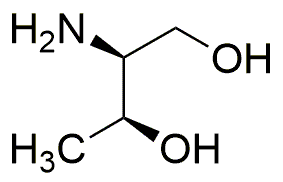D-Threoninol is widely utilized in research focused on:
- Pharmaceutical Development: It serves as a key intermediate in synthesizing various therapeutic agents, particularly in the formulation of anti-viral and anti-cancer drugs.
- Biotechnology: D-Threoninol is used in the production of amino acid derivatives, enhancing the efficacy of protein-based drugs and biopharmaceuticals.
- Cosmetic Industry: Its moisturizing properties make it a valuable ingredient in skincare products, helping to improve skin hydration and texture.
- Food Industry: It acts as a flavor enhancer and stabilizer in food products, contributing to improved taste and shelf-life.
- Research Applications: D-Threoninol is utilized in biochemical studies to understand metabolic pathways and enzyme functions, providing insights into cellular processes.
General Information
Properties
Safety and Regulations
Applications
D-Threoninol is widely utilized in research focused on:
- Pharmaceutical Development: It serves as a key intermediate in synthesizing various therapeutic agents, particularly in the formulation of anti-viral and anti-cancer drugs.
- Biotechnology: D-Threoninol is used in the production of amino acid derivatives, enhancing the efficacy of protein-based drugs and biopharmaceuticals.
- Cosmetic Industry: Its moisturizing properties make it a valuable ingredient in skincare products, helping to improve skin hydration and texture.
- Food Industry: It acts as a flavor enhancer and stabilizer in food products, contributing to improved taste and shelf-life.
- Research Applications: D-Threoninol is utilized in biochemical studies to understand metabolic pathways and enzyme functions, providing insights into cellular processes.
Documents
Safety Data Sheets (SDS)
The SDS provides comprehensive safety information on handling, storage, and disposal of the product.
Product Specification (PS)
The PS provides a comprehensive breakdown of the product’s properties, including chemical composition, physical state, purity, and storage requirements. It also details acceptable quality ranges and the product's intended applications.
Certificates of Analysis (COA)
Search for Certificates of Analysis (COA) by entering the products Lot Number. Lot and Batch Numbers can be found on a product’s label following the words ‘Lot’ or ‘Batch’.
*Catalog Number
*Lot Number
Certificates Of Origin (COO)
This COO confirms the country where the product was manufactured, and also details the materials and components used in it and whether it is derived from natural, synthetic, or other specific sources. This certificate may be required for customs, trade, and regulatory compliance.
*Catalog Number
*Lot Number
Safety Data Sheets (SDS)
The SDS provides comprehensive safety information on handling, storage, and disposal of the product.
DownloadProduct Specification (PS)
The PS provides a comprehensive breakdown of the product’s properties, including chemical composition, physical state, purity, and storage requirements. It also details acceptable quality ranges and the product's intended applications.
DownloadCertificates of Analysis (COA)
Search for Certificates of Analysis (COA) by entering the products Lot Number. Lot and Batch Numbers can be found on a product’s label following the words ‘Lot’ or ‘Batch’.
*Catalog Number
*Lot Number
Certificates Of Origin (COO)
This COO confirms the country where the product was manufactured, and also details the materials and components used in it and whether it is derived from natural, synthetic, or other specific sources. This certificate may be required for customs, trade, and regulatory compliance.


